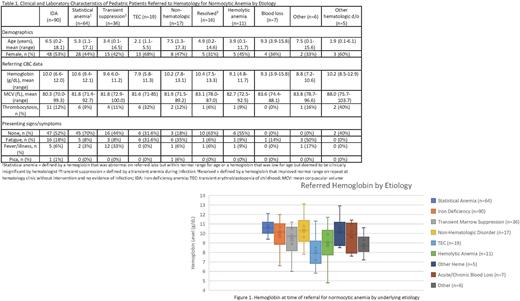Abstract
BACKGROUND: Normocytic anemia is a non-specific hematologic finding. Underlying etiologies are diverse, and patients may undergo extensive evaluations. Classically, adult patients have underlying chronic disease or inflammation as a cause for the anemia. However, chronic disease is less frequent in children than in adults, so consideration of other acute or transient etiologies is essential. However, sparse literature exists to inform an evidence-based approach to such patients. The objective of this study was to describe the clinical and laboratory characteristics of children referred to pediatric hematology for evaluation of normocytic anemia.
METHODS: This was a retrospective study of children ages 0 to 21 years referred to the Texas Children's Hospital Hematology Center in Houston, Texas for normocytic anemia from 1/1/2019 to 6/30/2021. All patients who had a diagnostic code of either D64.9 (anemia, unspecified), D46.4 (refractory anemia, unspecified), D64.0 (other anemias), D63.8 (anemia and other chronic diseases classified elsewhere), or R71.0 (abnormality of red blood cells) were collected and charts manually reviewed. Normocytic anemia was defined as a hemoglobin below normal and a mean corpuscular volume (MCV) within normal range, both defined by the referred laboratory results. Patients were excluded if there was a pre-existing diagnosis of chronic disease or inflammation, a platelet count <100 x 106/L, or an absolute neutrophil count (ANC) <1,000 x 103. Data extraction included demographics, clinical characteristics, diagnoses, and laboratory results. Descriptive statistics were employed for analysis of demographics and clinical characteristics, and analysis of variance was used to determine significant differences in mean hemoglobin and MCV, using RStudio©. This study was approved by the Baylor College of Medicine Institutional Review Board.
RESULTS: Of the 1,071 patients identified via the diagnostic code criteria, 782 were excluded due to anemia with an abnormal MCV (n=480), known underlying chronic disease (n=278), known malignancy (n=13), lack of hematology follow up (n=8), and no referred MCV available (n=3). Another 18 patients were excluded from statistical analysis due to being lost to follow up prior to establishing a diagnosis. Etiologies for the remaining 271 patients included iron deficiency (n=90), statistical anemia (n=64, defined as a hemoglobin normal for age or below the normal range but deemed non-pathologic by hematologist), transient marrow suppression (n=36), transient erythroblastopenia of childhood (TEC) (n=19), non-hematologic conditions (n=17, defined as a disorder that required care from a specialty other than hematology), resolved without intervention (n=16), hemolytic anemia (n=11), acute/chronic blood loss (n=7), other (n=6), and other hematologic conditions (n=5, defined as a hematologic disorder that is not iron deficiency, TEC, or hemolysis).
Within the iron deficiency group, 12% of patients (n=11) were found to have concurrent thrombocytosis. Within the transient marrow suppression group, there were 11% (n=4) with concurrent neutropenia. There was a lower mean hemoglobin in the group of patients with TEC as compared to patients with either iron deficiency, other hematologic issues, acute or chronic blood loss, or non-hematologic diagnoses as separate comparators (p<0.05). Patients with transient marrow suppression had a lower hemoglobin than patients with statistical anemia (p<0.05). Patients with hemolytic anemia had a lower hemoglobin than patients with transient marrow suppression (p<0.05). Patients with iron deficiency anemia had a lower MCV compared to patients with other hematologic issues (p<0.05).
CONCLUSIONS: Pediatric patients with normocytic anemia have diverse underlying etiologies, and few were diagnosed with an underlying chronic disease. Rather, the most common etiologies were iron deficiency and "statistical anemia.” Although iron deficiency anemia is classically known to cause microcytic anemia, our data suggests that patients presenting with normocytic anemia should also have iron testing performed. Our results also suggest that many patients may be followed in the primary care setting without the need for subspecialty care. This data will better inform our approach to accurately triage pediatric patients with normocytic anemia to determine what further evaluations are necessary.
Disclosures
Powers:Women's Health Research Collaborative (WHrC)/ The Kinetix Group: Membership on an entity's Board of Directors or advisory committees; Pharmacosmos LLC: Consultancy. Kirk:BioMarin: Honoraria.
Author notes
Asterisk with author names denotes non-ASH members.


This feature is available to Subscribers Only
Sign In or Create an Account Close Modal